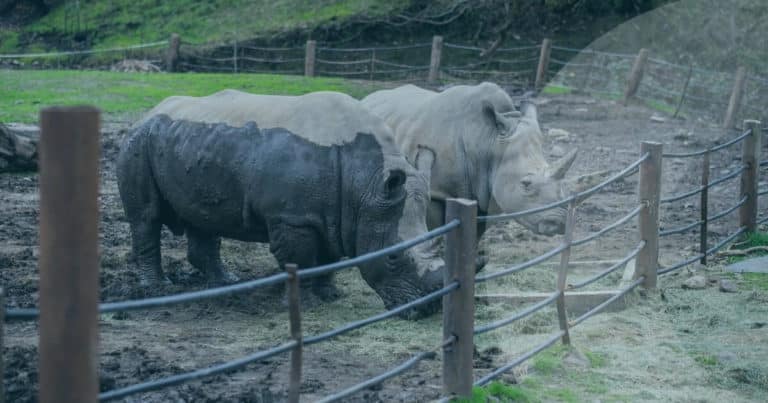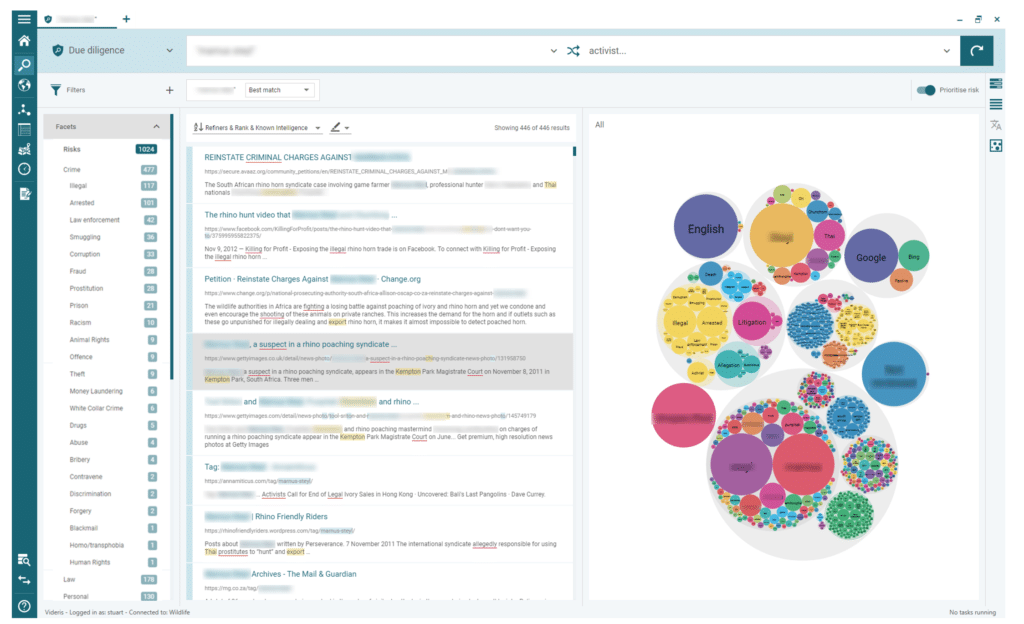Tracing a Wildlife Trafficking Network with Videris

Series: The Intelligence-Led Approach in Action
Introduction
In 2020, the UNODC (United Nations Office on Drugs and Crime) released the World Wildlife Crime Report. Amongst other disturbing revelations, the report revealed high volumes of global trafficking of elephant tusks and rhino horns. Between 2016-2018 an estimated 5.6 tons of rhino horn entered the illegal market and an estimated average of 10,000 elephants were illegally killed each year. Overall, between 2016-2018 the annual illicit income generated by ivory was US$400m and US$230m by rhino horn.
These horrific crimes have a long-lasting negative impact on the environment, the community, and the economy. Worse still, they are often connected to sophisticated global networks with reach that extends to human trafficking, drugs, and other serious and organised crimes. They are also hard to stop: these complex networks usually involve multiple individuals and companies, making it difficult to find key members. However, adopting an intelligence-led approach to these investigations, and supporting this approach with technology, can help to identify these networks and, ultimately, to prosecute those involved.
The Case
In this scenario, we are looking into a farmer who is suspected of involvement in wildlife-related crimes. Using Videris, we can explore these crimes in greater detail and illustrate the effectiveness of an end-to-end investigations platform in tackling global challenges like wildlife trafficking.*
Beginning an investigation
In this investigation we begin with very limited data: we only have the name of an individual. However, Videris allows the investigator to quickly build a picture of an individual even when only small amounts of data are available. As we suspect the subject of investigation of involvement in crime, we run a Videris risk search against the individual’s name. This type of search applies a series of risk-related terms against our keyword to identify results of relevance and possible concern, averting the need for an investigator to construct the complex Boolean search needed to run this in a normal search engine. Having run this search, we are presented with a series of results ranked by risk, and we can visualise these search results for easier digestion and thematic filtering if required. From this view, we can also take advantage of the filters on the left of the page to quickly identify any references to a particular risk – for example, smuggling.

Adding further intelligence to our investigation
The search results and web pages identified through our risk search can be viewed within the secure Videris Browser, which immediately highlights key intelligence in our Videris operation so that the investigator can quickly identify the relevant parts of the page. When reviewed, the web page content indicates that our initial subject of investigation has some connections with wildlife crimes. By inspecting the web page further, we are also able to extract new entities for further investigation (the areas highlighted in yellow), including the names of two other people. These two people can be added to the Videris chart which acts as a canvas for our investigation, giving us the the beginnings of our network.

The secure Videris browser anonymises the investigator and highlights key intelligence.
Corporate network mapping
Next, we want to understand more about the two new person entities we have discovered. A good first step is to determine if these individuals are linked to any companies, which we can achieve quickly within Videris by searching each of the individual’s names for officer records. Videris offers integrations with multiple sources of global corporate records data, including OpenCorporates, Bureau Van Dijk, ICIJ and OCCRP. When running a corporate records search, Videris will simultaneously search for any aliases, such as the same name written in a different language or script, saving the investigator time.

Identifying connections
As a result of our corporate records search, we have identified a new individual of interest, alongside several aliases, date of birth and nationality, and an image. Videris also helps the investigator to spot additional connections: the red glyph on the icon suggests there may be further information associated with this individual. By clicking on these markers, we can reveal possible connections to data already in our investigation. Whilst Videris will never make decisions on behalf of the investigator, it provides useful prompts that prevent us from missing key connections or insights. Further connections to people of relevance have been found, as well as new companies that we might want to investigate further. By searching the Videris integration with Refinitiv World-Check One, we can also identify that this person has already been connected to criminal activity.

Expanding our network
At this point, we have used Videris to penetrate several layers of a network, quickly turning one name into several other names of interest, as well as additional companies and some location information. By continuing to explore each of these entities further, we can build up a picture of the network.
We have also found location data and addresses associated with this network, people and companies. Using Videris to plot this information on a map allows us to see the true scale and impact these crimes have. It’s clear that the crimes are far-reaching, touching countless countries and communities across the globe.

A powerful solution
This is a great example of the intelligence-led approach in action: our investigation is directed by the investigator, with Videris augmenting their skills and experience with access to open source data on a global scale, highlighting key information and allowing them to visualise the findings in a meaningful and compelling way. Furthermore, Videris ensures that the investigation remains secure and that all evidence is captured and sourced for further review or escalation. If you are interested in understanding how Videris can help your organisation tackle complex investigations, please get in touch here.
1 World Wildlife Report 2020 by UNODC
* Note – names have been blurred and/or redacted.


